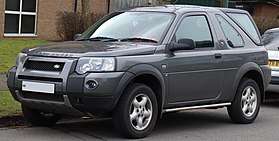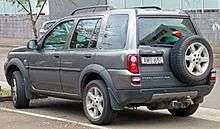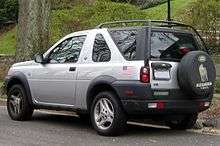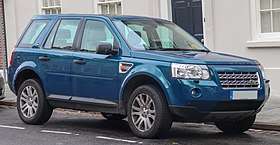Land Rover Freelander
The Land Rover Freelander is a two and four-door, five passenger, all-wheel-drive compact sport utility vehicle (SUV) manufactured and marketed by Land Rover,[1] in both two-wheel and four-wheel drive versions, across two generations from 1997 to 2014. The second generation was marketed from 2007–2014 in North America and The Middle East as the LR2 and in Europe as the Freelander 2.
| Land Rover Freelander | |
|---|---|
 Land Rover Freelander 2 Dynamic SD4 | |
| Overview | |
| Manufacturer | Land Rover |
| Production | 1997–2014 |
| Assembly | Halewood Body & Assembly, Halewood, United Kingdom Pune, India Changsu, China Aqaba Assembly Plant, Jordan |
| Body and chassis | |
| Class | Compact SUV |
| Layout | Transverse front-engine, front-wheel drive or four-wheel drive |
| Chronology | |
| Successor | Land Rover Discovery Sport Range Rover Evoque |
Using a monocoque (unibody) structure,[2] the Freelander was replaced by the Discovery Sport in 2015.[3]
First generation (L314; 1997–2006)
| First generation (L314) | |
|---|---|
 Facelift Freelander Sport 3-door | |
| Overview | |
| Production | October 1997–Late 2006 |
| Assembly | Solihull, United Kingdom Rayong, Thailand |
| Designer | Gerry McGovern (1992) |
| Body and chassis | |
| Body style | 5-door SUV 3-door convertible |
| Powertrain | |
| Engine | 1.8 L K-Series I4 2.5 L Rover KV6 V6 2.0 L BMW M47 TD I4 2.0 L L-Series TD I4 |
| Transmission | 5-speed automatic 5-speed manual |
| Dimensions | |
| Wheelbase | 101.0 in (2,565 mm) |
| Length | 2001–2003 5-door: 175.0 in (4,445 mm) 2004–2006 5-door: 174.1 in (4,422 mm) 3-door: 175.1 in (4,448 mm) |
| Width | 2001–2003: 71.1 in (1,806 mm) 2004–2006: 71.2 in (1,808 mm) |
| Height | 2001–2003 5-door: 68.9 in (1,750 mm) 2004–2006 5-door: 69.0 in (1,753 mm) 3-door: 67.2 in (1,707 mm) |


Market research by the Rover Group in the late 1980s suggested that Land Rover could enter the compact SUV market segment. In the early 1990s, the Rover Group had a restricted product development budget and looked for a partner to develop the project, which was codenamed CB40 (after Canley Building 40, where the concept was initially developed). Rover's then-partner Honda declined and chose to develop its own CR-V model that was launched in 1995.
Rover decided to work independently, using existing parts and components including a much modified Rover 200 floorpan, and minor components such as interior door handles from other Rover vehicles. When BMW took over Rover Group in 1994, the project received capital proceed. In December 2007, Autocar reported that early development designs and sketches of the Freelander featured Hyundai badging, suggesting that a tie up between both manufacturers. The design of the Freelander was by Gerry McGovern, who went on become the head of design at Land Rover in 2007.[4]
Land Rover initially intended to subcontract the manufacture of the Freelander to Valmet in Finland. BMW terminated this agreement on acquiring the Rover Group, and instead funded production facilities at Solihull, making use of the Rover SD1 assembly hall which had been inactive in the early 1980s, when Rover car production was moved to Cowley.
The Freelander was launched in October 1997 and became Europe's best-selling four-wheel drive model until 2002.[5] The last Freelanders in North America were sold as 2005 models.
Model variations


There were a variety of models, based around five-door estate and three-door softback (semi-convertible), hardback, and commercial (van-like) versions. In 2004, Land Rover introduced an improved and upgraded version of the Mark I; changes included a new interior and major external revisions, including a new face and rear.
The three-door model was available in E, S, ES, Sport and Sport Premium trim and the five-door model in available in E, S, ES, HSE, Sport and Sport Premium trim.
Engines
Engine choices included:
- 1.8-litre I4 Rover K-Series petrol (1997–2006), badged as '1.8i', 'Xi' or 'XEi' (Not sold in North America)
- 2.0-litre I4 Rover L-series diesel (1997–2000), badged as 'Di', 'XDi' or 'XEDi'
- 2.0-litre I4 BMW M47 diesel (2001–2006), badged as 'Td4'
- 2.5-litre V6 Rover KV6 Engine petrol (2001–2006), badged as 'V6'
Manual gearboxes dominated the early models, but automatic Tiptronic-style gearboxes (Jatco JF506E) became increasingly popular and were standard on the V6. The Automatic Tiptronic gearbox was also available as an option on the Td4.
Marketing
The first generation Freelander was used in the 1998 Camel Trophy and participated in Land Rover's G4 Challenge. The vehicle represented a compromise because it did not have a low-range gear selection, nor a locking differential, as found on larger Land Rover models. This meant that in comparison to other Land Rovers, off-road performance was not as good. In comparison to similar models produced by other manufacturers in the same period of time like the Honda CRV or the Toyota RAV4, however, the first generation Freelander was far more competent off-road.
It had more than sixteen patented features, including the IRD or Intermediate Reduction Drive, which acted as a front differential and fixed ratio transfer; the VCU or viscous-coupling, which reacts to the differing rotational speed of the prop shafts, allowing varying torque across itself; and the Hill Descent Control system, which was then implemented in the rest of the Land Rover range and even in the first generation BMW X5. (BMW was the parent company of Rover Group at the time of the introduction of this model).
This first generation also used a Traction Control system and a special version of ABS produced by Wabco and modified to assist driving in off-road situations. Lack of the MG Rover K18 and KV6 engines after the end of the MG Rover production led Land Rover to discontinue the model on 31 August 2005 in the U.S. and Canada.
Freelander 2 (L359; 2006–2014)
| Freelander 2 (L359) | |
|---|---|
 Pre-facelift Land Rover Freelander 2 HSE TD4 | |
| Overview | |
| Also called | Land Rover LR2 (North America & Middle East) |
| Production | 2006 – December 2014 |
| Assembly | Halewood Body & Assembly, Halewood, United Kingdom Pune, Maharashtra, India (CKD)[6] Changsu, China Aqaba Assembly Plant, Jordan |
| Body and chassis | |
| Body style | 5-door SUV |
| Platform | Ford EUCD platform |
| Related | Volvo XC60 Volvo S80 Ford Mondeo (third generation) |
| Powertrain | |
| Engine | Petrol engines: 2.0 L Ford EcoBoost 243 PS I4 3.2 L Ford SI6 233 PS I6 Diesel engines: 2.2 L Ford Duratorq 150 PS eD4 2.2 L Ford Duratorq 160 PS TD4 2.2 L Ford Duratorq 190 PS SD4 |
| Transmission | 6-speed Getrag M66EH50 manual 6-speed Aisin AWF21 automatic |
| Dimensions | |
| Wheelbase | 104.7 in (2,659 mm) |
| Length | 177.2 in (4,501 mm) |
| Width | 75.2 in (1,910 mm) |
| Height | 68.5 in (1,740 mm) |
| Kerb weight | 3,902–4,300 lb (1,770–1,950 kg) |
The second generation was internally designated L359; debuted at the 2006 British International Motor Show and was marketed as the Freelander 2, retaining the Freelander name in Europe and marketed as the LR2 in North America and The Middle East — mirroring the marketing of the new third generation Land Rover Discovery as LR3. A presentation at the Kensington Roof Gardens was held for journalists featuring celebrity tennis player Maria Sharapova.[7] Production ended at the end of 2014.[8]

_TD4_wagon_(2015-07-03)_02.jpg)
The second generation Freelander is based on the Ford EUCD platform, which itself is based on the Ford C1 platform. The Ford EUCD platform will be used by more upcoming vehicles from Volvo. The engine range is all-new for Freelander, featuring transversely-mounted 3.2-litre straight-six engine of the Ford SI6 series, which debuted in the new Volvo S80, as well as the 2.2-litre DW12 common rail turbodiesel engine, co-developed by Ford and PSA Peugeot Citroën.
Unlike previous Land Rovers, the second generation Freelander is manufactured in the Halewood Body & Assembly facility, near Liverpool, and was until 2009 manufactured alongside the Jaguar X-Type — as Jaguar X-Type and Landrover Freelander both used modified version of Ford's front wheel drive platform. The new Freelander features higher ground clearance and off-road capabilities that are closer to other Land Rover models.[9]
.jpg)
The second generation has improved quality interior with more safety features as standard.[10] The Freelander 2 features a modified version of the Terrain Response off-road driving system as fitted to the Discovery 3 and the Range Rover. The 4WD system was developed in conjunction with Haldex and was called Third generation coupling. Vehicles from the 2009 model year are fitted with a modified design of the active on-demand coupling, known as Haldex's Fourth generation.
The new Freelander was first marketed in the U.S. in 2007 as the LR2. The 2008 version is called the LR2 HSE. The limited run HST had added side trim, front valance, and 19-inch wheels. A Ford 3.2-litre inline six-cylinder engine producing 230 hp (170 kW) is standard, with a six-speed automatic transmission and all-wheel drive. In the United Kingdom, the standard engine is the Ford 2.2-litre diesel. The TD4 version of the engine produces 150 hp (110 kW) and 160 hp (120 kW), while the SD4 comes with 190 hp (140 kW).
Interior appointments include an Alpine 440-watt 14-speaker surround sound audio and a 7-inch touch navigation screen options, while the newer models can be equipped with an Meridian audio system, which comes with a surround sound 17-speaker system with Trifield technology, producing 825 Watts.
The Meridian system is also equipped with subwoofers and Audyssey MultEQ audio tuning system. Also a 5-inch colour display screen is standard even at the newer entry-level models. An optional cold climate package includes heated front windscreen, heated front seats with two heating levels and heated windscreen washers. The optional lighting package includes bi-xenon headlights, adaptive front-lighting, memory for the driver seat, as well as exterior mirrors and approach and puddle lamps.
Freelander 2 TD4_e
The Freelander TD4_e features stop-start technology to improve fuel economy and reduce carbon emissions. The system cuts out the engine when the vehicle is stationary, neutral is selected and the clutch engaged; the engine restarts when the clutch pedal is depressed.[11]
The system includes a heavy-duty starter motor that also acts as a generator to recover energy through regenerative braking that is then stored in capacitors to restart the engine reducing stress on the vehicle's battery and electrical system.[12] The stop-start system became available in spring 2009 on Freelander 2 TD4 models.
Freelander 2 eD4
For the 2011 model year, the option of two wheel drive (badged as eD4) was available. This version also lost Terrain Response and Hill Descent Control. For the 2014 model year, the Freelander gets a revised look with a grill and new interior piece.
Worldwide sales
Total sales are from 2009 only.
| Year | Sales |
|---|---|
| 2009 | 37,909 |
| 2010 | 54,833 |
| 2011 | 51,954 |
| 2012 | 48,332 |
| 2013 | 57,691 |
| 2014 | 56,622 |
| 2015 | 3,278 |
| Total | 310,619 |
References
- "Joint Venture, Subsidiary and Associate Companies: Jaguar Land Rover". Tata Motors. Archived from the original on 6 December 2010. Retrieved 21 August 2010.
- "New Land Rover LR2 / Freelander 2 debuts in London". Autoblog.com.
- Steve Cropley. "2015 Land Rover Discovery Sport - pricing, specs and video". autocar.co.uk.
- "New design boss for Land Rover". Car Magazine. 14 August 2006. Retrieved 14 June 2015.
- You & Your Land Rover Freelander - Buying, enjoying, maintaining, modifying; Haynes Publishing; 2003, page 54
- "Jaguar Land Rover Opens Assembly Plant in India, Rolls Out its First Model". carscoop.blogspot.com. 27 May 2011. Archived from the original on 31 May 2011. Retrieved 11 August 2011.
- Maria Sharapova reveals the all-new LR2 Archived 28 September 2007 at the Wayback Machine
- "DISCOVERY SPORT PRODUCTION BEGINS". Land Rover Owner International. 21 October 2014. Retrieved 14 June 2015.
- "What Car First look: new Land Rover Freelander – Introduction". Whatcar.com. 20 June 2006. Retrieved 30 September 2010.
- "European report on Freelander safety". Euroncap.com. Retrieved 30 September 2010.
- Baker, Erin (12 December 2008). "Land Rover Freelander TD4_e launch of the first of its low-emissions initiatives". Telegraph.co.uk. Retrieved 30 September 2010.
- "Land Rover Freelander 2 TD4_e (2009–) | Car Review | Road Test | 4car". Channel 4. Archived from the original on 14 May 2009. Retrieved 30 August 2009.
- "Tata Motors - Investors - JLR Volumes". tatamotors.com. Archived from the original on 31 July 2017. Retrieved 1 May 2014.
External links
| Wikimedia Commons has media related to Land Rover Freelander. |
- Freelander at Land Rover International